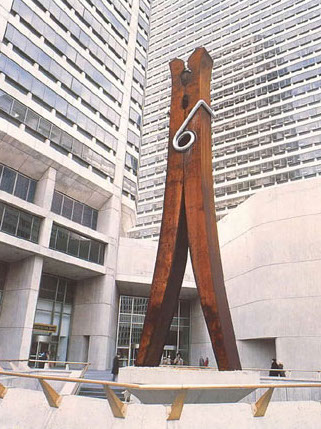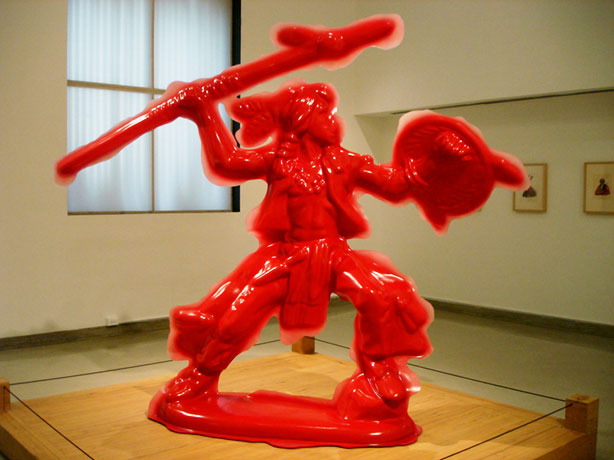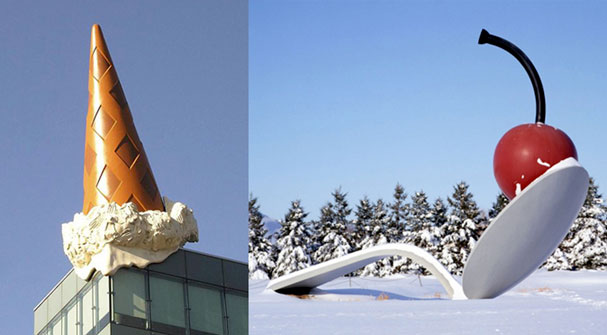
Your feedback and comments are appreciated. See Contact page for e-mails.
How Big Is It?
—On Scale in Art
by Richard Rivera
Scale, as size in relating to human
proportions, plays a major part in
the way that artwork is perceived,
be it a drawing, painting, photo-
graphic image, or sculpture.
The first time I saw Leonardo da Vinci's Mona Lisa (La Gioconda) in person I was surprised at how small the painting was. But as I stood in front of it, its smallness vanished and I was drawn into an intimate experience. Its size lures you into an intuitive understanding of the delicate and subtle process of painting and da Vinci's mastery of brushwork.
Standing in front of Franz Kline’s black and white 6 foot paintings transforms a single brushstroke into a physical presence. And Henry Moore’s stone sculptures at 10 feet in height achieve a towering majesty not possible if they were twenty-four inches high. Our own human scale becomes the inherent evaluator as to how we conceive what is possible. One can easily imagine carrying a box eight inches in size, but it is difficult to conceive carrying an 8 foot corrugated cardboard box.
Our imagination also plays an integral part in how we envision and perceive art. I recall being dazzled by Yoram Wolberger’s 6 foot sculpture of a plastic toy figure, excess casting edges and all (Red Indian #4, The Brooklyn Museum). The original toy on which Red Indian #4 is based on, was a toy which I played with in my childhood, and was one-and-a-half inches high. In person, at a six-foot height the sculpture challenged my imagination with its scale, forced me to re-think what I thought possible, and caused so many memories to re-emerge that it was remarkable. I stood there in awe, entertained by the sculptor’s unique perspective and brilliance.
Scale is a powerful thing. But it does not make up for a lack of concept. Increasing the size of something alone is magical to a degree, because it makes a mockery of our human size and forces us to project from a different perspective, but that alone does not imbue an object with an aesthetic that touches our humanity.
That is one of the questions that tasks us when we encounter Claes Oldenburg’s oversized sculptures. However, Oldenburg adds another element, playfulness, that transforms his everyday objects into Pop Art sculptures that remind us of what it means to be human, such as his forty-five foot Clothespin in Philadelphia, or his melting ice cream Dropped Cone in Cologne, Germany.
Today, the vast majority of us arrive at a perception of many things in the world from the minuscule images we view on the internet via our computers, or even smaller, on our smartphones. Our view of the world has shrunk to what we carry in our hands. It is a distorted perception that is difficult to escape because it taints our view of everything in the world. Especially how art is seen and perceived.
Should we assume that because an image is small it will have little impact when enlarged to a huge size? Or that a powerful image on Instagram will also be as effective as a wall-sized poster? Scale is an integral part of how an image is conceived by the artist. Scale and execution go hand-in-hand and should not be disassociated.
In our digital age the resolution of an image—the degree of fine reproducible detail—
is integral to the impact of the image. Often, resolution is the determining factor as to how large and in what media, an image is reproduced. An image that has enough fine detail to be a dazzlingly rich experience at a six-foot dimension is usually impossible to appreciate at a three-inch height, and may in fact look mediocre. In contrast, an image perfect for InstaGram would appear vastly pixilated and crude at a four-foot height, in effect distorting the message of the image.
In decades past when much of our information came from newspapers and magazines, ironically enough, the challenges were not as great. A viewer’s expectations were different. Today with the advent of high-resolution computer screens and handheld devices we tend to make certain assumptions as to how something really looks. We make the leap that if it looks this way on screen, it must appear that way in reality. Viewing Wolberger’s Red Indian #4 on my computer screen, it appears comical. It does not elicit the awe that its physical presence inspires.
Given that our technology does not allow us to enlarge or reduce artwork exponentially and still retain the inherent detail and resolution of the original, it is impossible to publicize large art in a way that does not diminish or distort it. We once again have to resort to galleries and the art market for the display of actual art objects.
June 10, 2015



Dropped Cone, and Spoonbridge and Cherry
Yoram Wolberger Red Indian #4
Claes Oldenburg's Clothespin in Philadelphia
Camera Sense Archives
APRIL 2015
Book review
iPad software
Movie review
Underwater dual-use camera review
Photo commentary
Book review
PhotoTech commentary
The Interview, movie review
Photo enhancement or management
MAY 2015
Photo Tech commentary
Photo/Art commentary
Camera review
TV series review
JUNE 2015
JULY 2015
AUGUST 2015
SEPTEMBER 2015
OCTOBER 2015
NOVEMBER 2015
DECEMBER 2015
Copyright © 2015 Richard Rivera & Rivera Arts Enterprises All rights reserved. No copying or reproduction of any kind without express written permission from Richard Rivera
Legal Disclosure Camera Sense and Eagles of New York are trademarks of Elk Partners LLC